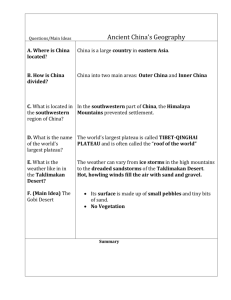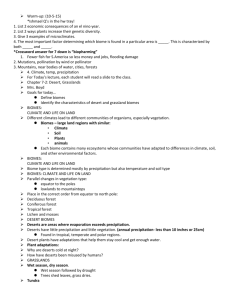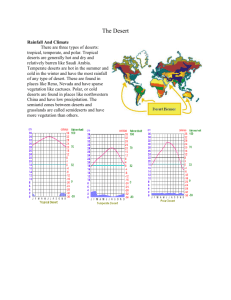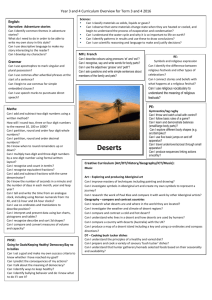File - Leaving Certificate Geography
advertisement
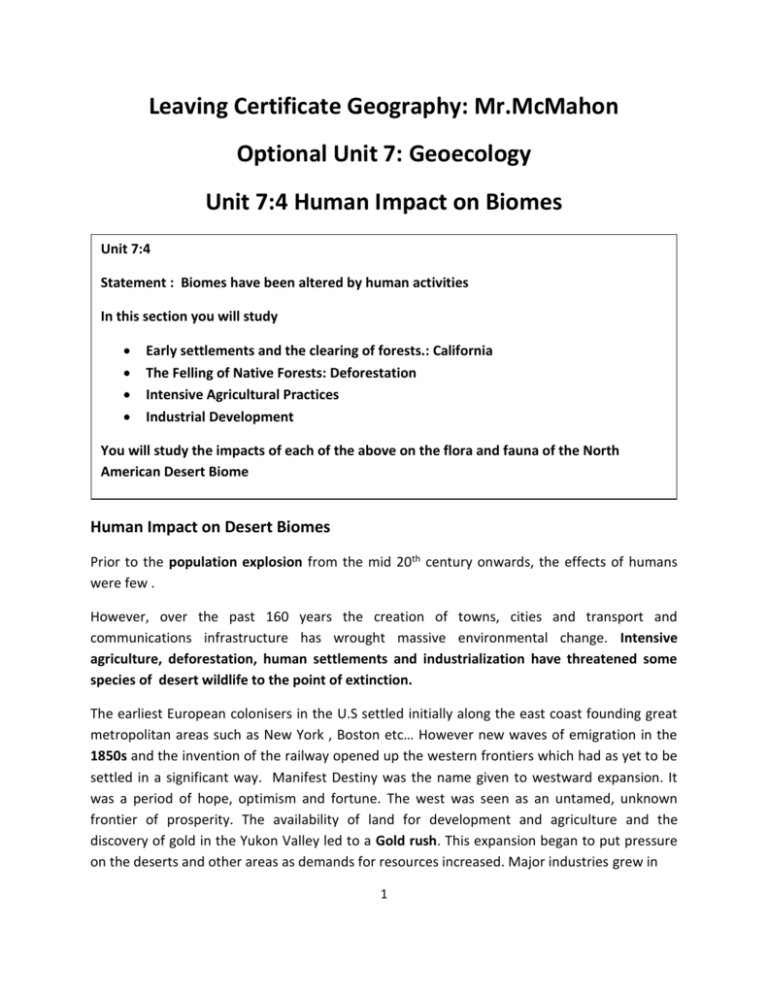
Leaving Certificate Geography: Mr.McMahon Optional Unit 7: Geoecology Unit 7:4 Human Impact on Biomes Unit 7:4 Statement : Biomes have been altered by human activities P In this section you will study Early settlements and the clearing of forests.: California The Felling of Native Forests: Deforestation Intensive Agricultural Practices Industrial Development You will study the impacts of each of the above on the flora and fauna of the North American Desert Biome Human Impact on Desert Biomes Prior to the population explosion from the mid 20th century onwards, the effects of humans were few . However, over the past 160 years the creation of towns, cities and transport and communications infrastructure has wrought massive environmental change. Intensive agriculture, deforestation, human settlements and industrialization have threatened some species of desert wildlife to the point of extinction. The earliest European colonisers in the U.S settled initially along the east coast founding great metropolitan areas such as New York , Boston etc… However new waves of emigration in the 1850s and the invention of the railway opened up the western frontiers which had as yet to be settled in a significant way. Manifest Destiny was the name given to westward expansion. It was a period of hope, optimism and fortune. The west was seen as an untamed, unknown frontier of prosperity. The availability of land for development and agriculture and the discovery of gold in the Yukon Valley led to a Gold rush. This expansion began to put pressure on the deserts and other areas as demands for resources increased. Major industries grew in 1 Felling Trees: Deforestation. The Creation of Permanent Settlements Developing intensive Agriculture Creating Heavy Industry The largest population to grow in the west and south-west were California and Texas. California With a population of 37 million California is the third most populous state in the U.S. It became the 31st state in 1850. Upon accession to state hood its population began to grow rapidly with European settlers coming from the West and Asian settlers to a lesser extent from the east. Over the course of a century the population of the state exploded 100 fold 1850 - 100,000 1900 - 1, 500,000 1950 - 10, 000,000 2000 - 35,000, 000 2050 - 50, 000,000 (projected) The continued growth of California is putting a strain on already scarce resources. Deforestation The settlement of California led to a huge demand for timber. Timber was used to build homes and entire towns quickly. It was also in great demand in the mining industry during the gold – rush where it was used to create trusses and scaffolds to stop mines from collapsing. Fencing in land for ranches was another use. Timber was cut at first by hand and then by saw-mills which could be either portable or permanent. The logging industry became a lucrative one and the profits were huge. The arrival of the railway on the east- coast was also of benefit to the industry. The timber was used as sleepers for the railways and in the construction of bridges. The railway also opened up markets on the east coast for Californian timber. 2 Expansion of the United States 3 The felling of the Californian forests had disastrous effects on some areas. In parts of the coastal ranges where pine trees flourished the soil was loosened and eroded. It also affected the habitat of animals and birds. Native trees to the region were also endangered. The giant Redwood trees known also as Sequoias were endangered. These trees can grow up to 300ft in height. 96% of them have been lost and those remaining are protected by Federal and State Laws. Reservations such as Headwaters Forest are in Californian State ownership. Permanent Settlement Some of the major urban centers in the North American desert biome include Sonoran Desert: Phoenix ,Arizona 4.5 million Great Basin : Reno ,Nevada 2 Million Chihuahua: Albuquerque: New Mexico 850,000 Mojave: Las Vegas Nevada 1.8 million. Native Americans (Amerindians) had lived in the desert biome since antiquity. While some tribes had created permanent settlements they were mostly nomads. The Native Americans had a profound respect for the land and nature. They took only what they regarded as being essential to their survival recognizing that was taken from the earth had to be replaced. Far from seeing themselves as being above nature they saw themselves very much as part of it. The new colonizers on the other hand sought to subdue the land and take its resources for profit. The 1800s saw great change in the U.S as the industrial revolution spread across the continent along with millions of emigrants from Europe. New settlers from Asia also arrived and settled along the Pacific coast. Many came during the Gold Rush and later abandoned their settlements once it had finished. From the 20t century onward the population exploded. Texas today has 23 million people and California 36. A further 12.7 million live in the states of Idaho, Utah, Arizona, New Mexico and Nevada. These states are located in the desert biome. As these populations grow they are having a massive impact on the desert eco-system. 500km2 of natural habitat is lost every year to commercial and residential development. The consequence of this is that many plants and animals are becoming endangered species and face the threat of extinction. In 1973 the Endangered Species act became Federal Law. It was designed to protect species such as the desert tortoise and bald eagle. The impact of the humans upon the desert biome is problematic in many ways. New residents are often unfamiliar with desert wildlife and vegetation. Animals and plants are killed out 4 5 ignorance and fear. People rarely see the view that it is they who are invading the animal’s territory and not vice-versa. To remove or harm a Saguaro Cactus in any way is illegal by state law in Arizona and special consideration must be given to them when planning motorways or housing projects. Intensive Agriculture The effects of overgrazing are visible across the states situated in the deserts. During the westward expansion of the 1800s herding cattle became a huge industry and source of wealth. Cattle were moved in huge herds in a practice called ‘cattle drives’. This practice was carried out to move cattle from one pasture to the next and to move from farm to market place. This led to overgrazing in many areas. Sheep farming was introduced on higher ground, on areas of marginal land where the naturally thin vegetation was completely stripped in many areas. As intensive grazing stripped the land of its vegetation soil erosion and the destruction of natural habitats also took place. Attempts to replace the lost vegetation cover with European varieties of grasses and seeds were met with limited success. This was largely because temperatures in the desert areas are too warm for temperate vegetation to grow and in many areas soils had been leached, eroded or salinised. In more recent times African grasses from the fringes of the Sahara have been introduced to the Sonora desert and have proven to be more successful. Its presence could have a profound impact in helping to convert the land to intensive farming. Agriculture accounts for 1/10 jobs in California. Intensive market gardening of citrus fruits, vegetables and grapes takes place in the Central Valley. The ‘OC’ or Orange County in northern California around Sacramento is famed for its citrus fruits. Agri-business in this region was made possible by the creation of a huge Irrigation scheme called the Central Valley project. This involved creating dams and reservoir s along the courses of the San Joachin and Sacramento Rivers. The construction of the dams has altered the natural courses of both rivers . Valuable farmland was lost when land was flooded to create the reservoirs and intensive irrigation has lowered the natural water table. This has led to salinisation of soils in some areas where there is no water to wash them away. Run-off water from agriculture has also poisoned the land with pesticides which has also been washed into the water table. The pesticides in turn have led to the growth of algae which uses up all the oxygen in rivers and lakes leading to massive fish kills and a reduction in water quality for human, animal and plant consumption. 6 Industrial Development The 20th century saw the dawn of the nuclear age. Early tests in the development of nuclear missiles took place in the North American deserts. Los Alamos in New Mexico was the site of the test explosions of what led to the nuclear arms race. Some Facts In the period 1950-1961 100 detonations of A-Bombs took place in the deserts. 15,000 people died from cancer. 100,000 contracted cancer. Lands were made sterile and will be unable to support agriculture for up to a thousand years. 4000 tonnes of nuclear waste has been stored under Yuca Mountain. In the Nevada test site there were 28 military complexes, 10 helipads, 1100 buildings, 400 miles of paved roads and two airstrips. The facts outlined above illustrate the impact that industrial development has had on the desert biomes. During the presidency of Dwight Eisenhower (1952-1960) the U.S interstate programe was launched. Over 4000 miles of highway called the interstate was built linking all of the major cities of all 50 states across the U.S. The interstate was part of the consumer society created after the war. This period is also referred to as the ‘baby boom years’ as the population exploded. The interstate facilitated the growth of towns and cities and the spread of industry. Another factor was the growth of the ‘industrial military complex’. At the height of 7 the ‘Cold –War’ 1945-1990 America was refining its nuclear capability. The deserts offered the military an ideal zone of development for the following reasons. Flat land for the construction of buildings Air space in which ‘no fly’ zones could be established. Being far from population centers they were an ideal zone for secret munitions testing. From a military point of view the loss of animal and plant life in the deserts as a consequence of nuclear explosions were viewed as collateral damage. However, this was far from being the case as lands have been rendered sterile and unsuitable for habitation for up to a thousand years. Tourism The desert region of the US has always drawn million of tourists to the region who have been attracted by its world famous locations The Grand Canyon located on the Colorado. Monument Valley National Park. The backdrop scene to hundreds of Hollywood movies in particular those of the western genre. Yellowstone National Park. Death Valley California. The interstate and budget air travel has facilitated the growth of tourism in the region. The famous Route 66 links Chicago-Los Angeles and passes through the Mojave Desert. Nevada’s relaxed laws on gambling are also a huge attraction Las Vegas being a major gambling center with its casinos, hotels and convention centers. Tourism is having a major impact on the desert region. There is an increasing demand for resources. Water is being taken from major lakes and rivers lowering the water table and denying water to soil. This has a negative impact on plants and vegetation. Being a consumer society car ownership in the U.S is huge. America pioneered the development of SUV’s and pick-ups as off road vehicles. The use of these vehicles in off-road areas is causing massive damage to vegetation and habitats In the Mojave desert. 8 In recent times the global recession and the 9/11 attacks in New York have caused many Americans to vacation at home. 9 Past Questions 2009 Q18 Assess how biomes have been altered by human activity. (80 m) 2008 Q16 Examine two ways in which human activities have altered the natural characteristics of a biome that you have studied. [80 m] 2007 Q18 Assess the impact of human activity on a biome that you have studied. [80m] 10 Notes 11



